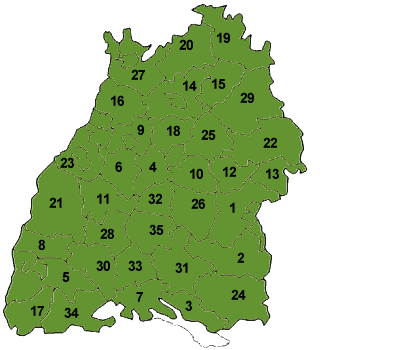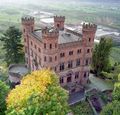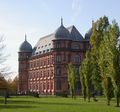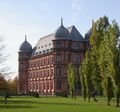بادن-فورتمبرج
بادن-فورتمبرج
Baden-Württemberg | |
|---|---|
 | |
| الإحداثيات: 48°32′16″N 9°2′28″E / 48.53778°N 9.04111°ECoordinates: 48°32′16″N 9°2′28″E / 48.53778°N 9.04111°E | |
| البلد | ألمانيا |
| Founded | 25 أبريل 1952[1] |
| العاصمة | شتوتگارت |
| الحكومة | |
| • الكيان | لاندتاگ بادن-ڤورتمبرگ |
| • الوزير الرئيس | Winfried Kretschmann (Greens) |
| • Governing parties | Green / CDU |
| • أصوات البوندسرات | 6 (of 69) |
| • مقاعد البوندستاگ | 102 (من 736) |
| المساحة | |
| • الإجمالي | 35٬751٫46 كم² (13٬803٫72 ميل²) |
| التعداد (2020-09-30)[3] | |
| • الإجمالي | 11٬111٬496 · الثالثة |
| • الكثافة | 311/km2 (810/sq mi) |
| منطقة التوقيت | UTC+1 (CET) |
| • الصيف (التوقيت الصيفي) | UTC+2 (CEST) |
| ISO 3166 code | DE-BW |
| GRP (nominal) | €524 billion (2019)[4] · 3rd |
| GRP per capita | €47,000 (2019) · 4th |
| NUTS Region | DE1 |
| HDI | 0.956 (2021)[5] very high · 3rd |
| الموقع الإلكتروني | baden-wuerttemberg.de |

بادن-ڤورتمبرگ Baden-Württemberg هي ولاية ألمانية (Land) في جنوب غرب ألمانيا، شرق الراين، الذي يشكل الجزء الجنوبي من الحدود الغربية لألمانيا مع فرنسا. وتحتل المركز الثالث باتساعها، إذ تبلغ مساحتها 35752 كم² يحدها غرباً فرنسة وإقليم راينلاند-پفالتس وجنوباً سويسرة وشرقاً إقليم باڤاريا ومن الشمال إقليم بافاريا وإقليم هِسِن. With more than 11.07 million inhabitants اعتبارا من 2019[تحديث] across a total area of nearly 35,752 km2 (13,804 sq mi), it is the third-largest German state by both area (behind Bavaria and Lower Saxony) and population (behind North Rhine-Westphalia and Bavaria).[6] As a federated state, Baden-Württemberg is a partly-sovereign parliamentary republic. The largest city in Baden-Württemberg is the state capital of Stuttgart, followed by Mannheim and Karlsruhe. Other major cities are Freiburg im Breisgau, Heidelberg, Heilbronn, Pforzheim, Reutlingen, Tübingen, and Ulm.
What is now Baden-Württemberg was formerly the historical territories of Baden, Prussian Hohenzollern, and Württemberg. Baden-Württemberg became a state of West Germany in April 1952 by the merger of South Baden, Württemberg-Baden, and Württemberg-Hohenzollern. These three states had been artificially created by the Allies after World War II out of the existing traditional states by their separation over different occupation zones.
Baden-Württemberg is especially known for its strong economy with various industries like car manufacturing, electrical engineering, mechanical engineering, the service sector, and more.[7][8][9] It has the third-highest gross regional product (GRP) in Germany. Part of the Four Motors for Europe, some of the largest German companies are headquartered in Baden-Württemberg, including Mercedes-Benz Group, Schwarz Group, Porsche, Bosch and SAP.
The sobriquet Ländle, a diminutive of the word Land in the local Swabian, Alemannic and Franconian dialects, is sometimes used as a synonym for Baden-Württemberg.[10][11][12]
. . . . . . . . . . . . . . . . . . . . . . . . . . . . . . . . . . . . . . . . . . . . . . . . . . . . . . . . . . . . . . . . . . . . . . . . . . . . . . . . . . . . . . . . . . . . . . . . . . . . . . . . . . . . . . . . . . . . . . . . . . . . . . . . . . . . . . . . . . . . . . . . . . . . . . . . . . . . . . . . . . . . . . . .
التاريخ
هذه الولاية تضم الولايات التاريخية بادن، هوهنتسولرن وڤورتمبرگ، التي هي جزء من منطقة سوابيا.
Baden-Württemberg is formed from the historical territories of Baden, Prussian Hohenzollern, and Württemberg.[13] Baden spans along the flat right bank of the river Rhine from north-west to the south (Lake Constance) of the present state, whereas Württemberg and Hohenzollern lay more inland and hillier, including areas such as the Swabian Jura mountain range. The Black Forest formed part of the border between Baden and Württemberg.
In 100 AD, the Roman Empire invaded and occupied Württemberg, constructing a limes[أ] along its northern borders. Over the course of the third century AD, the Alemanni forced the Romans to retreat west beyond the Rhine and Danube rivers. In 496 AD the Alemanni were defeated by a Frankish invasion led by Clovis I.
The Holy Roman Empire was later established. The majority of people in this region continued to be Roman Catholics, even after the Protestant Reformation influenced populations in northern Germany.
In the late 18th and early 19th century, Künzelsau, the capital of the Hohenlohe district, became the centre of emigration to the UK of pork butchers and bacon factors. The pioneers noticed a niche for speciality pork products in the rapidly growing English cities, especially those in the industrial centre and North. Many married local women and sent word home that a good living could be made in England; others followed.[14]
In the late 19th and early 20th centuries, numerous people emigrated from this primarily rural area to the United States for economic reasons.
القرن العشرون إلى الحاضر
In the beginning of the 20th century, the territory of modern-day Baden-Württemberg consisted of the Grand Duchy of Baden,[ب] the Kingdom of Württemberg[ت] and the province of Hohenzollern[ث] of the Kingdom of Prussia. Since 1871, these had been part of the German Empire. In the aftermath of World War I and as part of the German revolution of 1918, the monarchs of Baden,[ج] Württemberg[ح] and Prussia[خ] were deposed, and these states became democratic republics: the Republic of Baden, the Free People's State of Württemberg and the Free State of Prussia.
Following Adolf Hitler becoming chancellor of Germany in 1933, the democratic institutions of Baden, Württemberg and Prussia were abolished as part of the Gleichschaltung.
After World War II, the Allies established three states in the territory of modern-day Baden-Württemberg: (South) Baden,[د] Württemberg-Baden[ذ] and Württemberg-Hohenzollern.[ر] Baden and Württemberg-Hohenzollern were occupied by France, while Württemberg-Baden was occupied by the United States. The new artificial borders were a consequence of France requesting its own occupation zone in Germany after World War II, and the Americans' wish to keep the A8 motorway, which spans east-west across northern Baden and northern Württemberg, wholly within their occupation zone.
In 1949, each state became a founding member of the Federal Republic of Germany (West Germany), with Article 118 of the German constitution providing an accession procedure. On 9 December 1951, a referendum was held in Württemberg-Baden, Württemberg-Hohenzollern and (South) Baden over a possible merger, or the restoration of the former pre-war states.[6] There was strong support for the merger in Württemberg and Hohenzollern, but opposition in Baden. While a majority in the historic area of Baden (52%) voted to restore the former pre-war states, the majority of voters overall (69%) voted in favor of a merger.[6] Baden-Württemberg officially became a state on 25 April 1952.[6]
There were still opponents to the merger of Baden and Württemberg, however. In 1956 the Federal Constitutional Court decided that the population of Baden should have their say in a separate referendum. The second referendum was delayed, however, and the Federal Constitutional Court decided in 1969 that another referendum should be held by 30 June 1970. The referendum in the historic area of Baden was finally held on 7 June 1970, with 81.9% of the voters voting in favour of the merger of Baden and Württemberg.[15]
الجغرافيا
بادن-فورتمبرگ تقع في جنوب ألمانيا. يحدها من الشمال ولاية هيسين ومن الشرق بايرن ومن الجنوب بحيرة كونستانز وسويسرا ومن الغرب راينلاند-بفالز وفرنسا. أهم الأنهر هم الراين، نيكر والدانوب.
في جنوب غرب الولاية تقع الغابة السوداء.
تشرف الولاية من الغرب على المجرى الأعلى لنهر الراين وسهل الراين الخصب، حيث الغابات والمراعي تساير نهر الراين، وإلى الشرق من هذا السهل ترتفع كتلة الغابة السوداء، وإلى الشمال منها تظهر تلال أودين فالد وإلى الشرق من هذه المرتفعات يمتد حوض سوابيا-فرنكونيا Schwábich- Fránkische، وفي الزاوية الجنوبية الشرقية من الولاية تبدأ أقدام جبال الألب. وتتصف الولاية بظواهر مناخية محلية لتباين تضاريسها، فشتاؤها طويل قاسٍ يدوم فيه الثلج مدة طويلة، أما صيفها فمعتدل بوجه عام.
ومن أشهر أنهار بادن-ڤورتمبرگ نهر الراين والماين والنيكار والدانوب، وجميعها صالحة للملاحة، ولها دور في اقتصاد الولاية وفيها الكثير من البحيرات أهمها بحيرة كونستانس (بودن).
التوزيع السكانى
يبلغ عدد السكان نحو 10.426.040 نسمة (2000)، والكثافة 292 نسمة/كم². وهم من أصول متنوعة، ففيها الألمان والفرانك، كما يقطنها (الصوابيون) في مناطق واسعة.
التقسيم السياسي و أهم المدن
الولاية مقسمة إلى 4 مديريات و 12 اقليم و 35 دائرة ريفية و 9 دوائر مدنية.
العاصمة شتوتگارت, مانهايم, كارلسروهه، فرايبورگ، توبنگن، كونستانز، هايدلبرگ، بادن بادن و أولم هم أهم مدن بادن-فورتمبورگ.
وتقسم الولاية إدارياً إلى أربع محافظات، وتسعة مراكز مدن وأربع وستين ناحية وأهم مدنها:
ـ شتوتگارت (406.594 نسمة) (1994) وهي حاضرة الولاية ومركزها الاقتصادي.
- مانهايم (318,025 نسمة) Mannheim، وكارلسروِه (278,000 نسمة) Karlsruhe، وفرايبورگ (197,284 نسمة)، وهايدلبرگ (139,429 نسمة).
وهي تتمتع برخاء اقتصادي كبير، مع أنها تفتقر إلى القاعدة الاقتصادية الطبيعية فالخامات وموارد الطاقة الطبيعية شبه معدومة فيها.
وأبرز الصناعات فيها، صناعة السيارات ذات الشهرة العالمية، وصناعة الآلات والأجهزة الكهربائية والصناعة الكيمياوية والإلكترونيات، كما تشتهر مناطق أخرى فيها بصناعات مختلفة. أما في الزراعة فتبلغ نسبة الأراضي الزراعية في الولاية 49% من المساحة العامة، وتتصف بمزارعها المتوسطة والصغيرة المساحة ذات المنتوجات الزراعية المتنوعة مثل العنب والتبغ والفواكه والهليون وحشيشة الدينار والخضروات.
وتغطي الغابات نحو 37% من المساحة العامة للولاية.
والولاية ذات تراث حضاري وفكري وسياسي عريق، يظهر في المعالم التاريخية المنتشرة فيها كقلعة هوهنتسولرن التي كانت مقر الأسرة الپروسية الحاكمة، وكذلك قصر ليشتنشتاين وقصر الباروك إضافة إلى الكثير من الكنائس والمتاحف. كما تحوي الولاية تسع جامعات، أعرقها جامعة هايدلبرگ التي تأسست عام 1386 وجامعة فرايبورگ (1457) وجامعة توبنگن (1477) وغيرها.
ولقد أنجبت مقاطعتا بادن وفورتمبرگ كثيراً من أعلام الأدب والفلسفة والعلوم الطبيعية أمثال شيلر وهيگل وكيپلر وآينشتاين، وعدداً من السياسيين البارزين مثل تيودور هويز أول رئيس لجمهورية ألمانية الاتحادية. وفيها صنعت أول سيارة في العالم من قبل ديملر وبنز. وتشتهر الولاية بمنتجعاتها وأماكنها السياحية ولاسيما منطقة بحيرة كونستانس (بودن) ومنطقة بادن والغابة السوداء.
Furthermore there are nine independent cities, which do not belong to any district:
قائمة الوزراء-الرؤساء لبادن-ڤورتمبرگ
- 1952 - 1953: Reinhold Maier (FDP/DVP)
- 1953 - 1958: Gebhard Müller (CDU)
- 1958 - 1966: Kurt Georg Kiesinger (CDU)
- 1966 - 1978: Hans Karl Filbinger (CDU)
- 1978 - 1991: Lothar Späth (CDU)
- 1991 - 2005: Erwin Teufel (CDU)
- since 2005: Günther Oettinger (CDU)
الاقتصاد والبنية التحتية
بادن-فورتمبرغ هي أحد أغنى ولايات ألمانيا. نسبة البطالة تعد أحد الأقل في البلاد. شركات السيارات كدايملر-كرايسلر (مرسيدس)، بورشه، روبرت بوش وأودي تتخذ من الولاية مقر لها. كذللك مقر أكبر شركة برمجيات ألمانية ساب إى.جي. (SAP AG) يقع في مدينة ڤالدورف بالولاية.
مانهايم الواقعة على نهر الراين لديها ثاني أكبر ميناء داخلي بأوروبا.
التعليم والثقافة
أهم الجامعات: جامعة شتوتگارت، جامعة فرايبورگ، جامعة هايدلبرگ وجامعة كونستانز.
مواقع إلكترونية
موقع بادن-ڤورتمبرگ الرسمي: [1][2]
معرض الصور
Baden-Württemberg State Parliament in Stuttgart
The Black Forest is a popular vacation resort in Baden-Württemberg
Ortenberg Castle near Offenburg (now a Youth Hostel)
Old Town Hall in Esslingen
Castle Heidelberg
Old Town Hall in Tübingen
Old Castle in Stuttgart
New Castle in Stuttgart
Karlsruhe Castle at night
Gottesaue Castle in Karlsruhe
Castle in Ludwigsburg
Castle Sigmaringen
Sankt Blasien Abbey
Castle Weikersheim
Lake Bodensee, South Baden-Württemberg
Lake Bodensee, German side overlooking Austria
Black Forest Train near Karlsruhe
. . . . . . . . . . . . . . . . . . . . . . . . . . . . . . . . . . . . . . . . . . . . . . . . . . . . . . . . . . . . . . . . . . . . . . . . . . . . . . . . . . . . . . . . . . . . . . . . . . . . . . . . . . . . . . . . . . . . . . . . . . . . . . . . . . . . . . . . . . . . . . . . . . . . . . . . . . . . . . . . . . . . . . . .
المصادر
- ^ "25. April 1952 – Die Entstehung des Landes Baden-Württemberg". Archived from the original on 2015-04-07. Retrieved 21 August 2022.
- ^ "The State and its people". Baden-Württemberg. Retrieved 18 December 2016.
- ^ "Bevölkerung nach Nationalität und Geschlecht am 31. Dezember 2017". Statistisches Landesamt Baden-Württemberg (in الألمانية). 2018.
- ^ Baden-Württemberg, Statistisches Landesamt. "Bruttoinlandsprodukt – in jeweiligen Preisen – in Deutschland 1991 bis 2019 nach Bundesländern (WZ 2008) – VGR dL". www.vgrdl.de. Archived from the original on 25 June 2020. Retrieved 23 June 2020.
- ^ "Sub-national HDI - Area Database - Global Data Lab". hdi.globaldatalab.org (in الإنجليزية). Retrieved 2018-09-13.
- ^ أ ب ت ث "Our State". Baden-Württemberg. Retrieved 18 December 2016.
- ^ "Alles zum Thema Baden-Württemberg". rtl.de (in الألمانية). Retrieved 2021-01-02.
- ^ Germany, Stuttgarter Zeitung, Stuttgart. "50 größte Unternehmen in Baden-Württemberg: Daimler ist nicht in jeder Hinsicht Top". stuttgarter-zeitung.de (in الألمانية). Retrieved 2021-01-02.
{{cite web}}: CS1 maint: multiple names: authors list (link) - ^ "Baden-Württemberg: Die Top-Konzerne aus dem Südwesten". www.wiwo.de (in الألمانية). Retrieved 2021-01-02.
- ^ "man-English Dictionary: ["little country"; local nickname for the state of Baden Wuerttemberg]". dict.cc. Retrieved 29 January 2015.
- ^ "Baden-Württemberg: Kein schöner Ländle". ZEIT MAGAZIN. Retrieved 21 February 2017.
- ^ "Ländle". Duden Wörterbuch. Retrieved 18 September 2020.
- ^ Andrea Schulte-Peevers; Anthony Haywood; Sarah Johnstone; Jeremy Gray; Daniel Robinson (2007). Germany. Lonely Planet. ISBN 978-1-74059-988-7. Retrieved 1 February 2009.
- ^ "Home". www.rmford.co.uk.
- ^ "Entstehung des Südweststaats". Baden-Württemberg.de.
قالب:Germany districts baden-württemberg
خطأ استشهاد: وسوم <ref> موجودة لمجموعة اسمها "lower-alpha"، ولكن لم يتم العثور على وسم <references group="lower-alpha"/>
- CS1 الألمانية-language sources (de)
- Short description is different from Wikidata
- Coordinates on Wikidata
- Articles containing ألمانية-language text
- Lang and lang-xx code promoted to ISO 639-1
- مقالات فيها عبارات متقادمة منذ 2019
- جميع المقالات التي فيها عبارات متقادمة
- Articles with hatnote templates targeting a nonexistent page
- بادن-ڤورتمبرگ
- ولايات ألمانيا
- أقاليم التصنيف الأول في الاتحاد الأوروپي
- دول وأراضي تأسست في 1951
- صفحات مع الخرائط



























